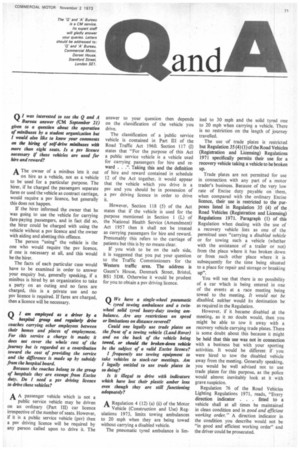Q We have a single-wheel pneumatic tyred towing ambulance and a
Page 73

If you've noticed an error in this article please click here to report it so we can fix it.
twinwheel solid tyred heavy-dray towing ambulance. Are any restrictions on speed or limitations on distance covered?
Could one legally use trade plates on the front of a towing vehicle (Land-Rover) and on the back of the vehicle being towed, or should the broken-down vehicle be the subject of a valid Excise licence?
I frequently use towing equipment to take vehicles to stock-car meetings. Am I legally entitled to use trade plates in so doing?
Is it illegal to drive with indicators which have lost their plastic amber lens even though they are still functioning adequately?
A Regulation 4 (12) (a) (ii) of the Motor Vehicle (Construction and Use) Regulations 1973, limits towing ambulances to 20 mph when they are being towed without carrying a disabled vehicle.
The pneumatic tyred ambulance is lim ited to 30 mph and the solid tyred one to 20 mph when carrying a vehicle. There is no restriction on the length of journey travelled.
The use -of trade plates is restricted but Regulation 35 (4)(1) of the Road Vehicles (Registration and Licensing) Regulations 1971 specifically permits their use for a recovery vehicle taking a vehicle to be broken up.
Trade plates are not permitted for use in connection with any part of a motor trader's business. Because of the very low rate of Excise duty payable on them, when compared with the ordinary Excise licence, their use is restricted to the purposes listed in Regulation 35 (4) of the Road Vehicles (Registration and Licensing) Regulations 1971. Paragraph (1) of this Regulation when dealing with the use of a recovery vehicle lists as one of the permitted uses "carrying a disabled vehicle or for towing such a vehicle (whether with the assistance of a trailer or not) from the place where it has broken down or from such other place where it is subsequently for the time being situated to a place for repair and storage or breaking up".
You will see that there is no possibility of a car which is being entered in one of the events at a race meeting being towed to the meeting. It would not be disabled, neither would its destination be as required in the Regulation.
However, if it became disabled at the meeting, as it no doubt would, then you might be able to tow it away with a recovery vehicle carrying trade plates. There is some doubt about this because it might be held that this use was not in connection with a business but with your sporting activities. It would be different if you were hired to tow the disabled vehicle away from the meeting. Generally speaking, you would be well advised not to use trade plates for this purpose, as the police would almost inevitably look at it with grave suspicion.
Regulation 76 of the Road Vehicles Lighting Regulations 1971, reads, "Every direction indicator . . . fitted to a vehicle shall at all times be maintained in clean condition and in good and efficient working order." A direction indicator in the condition you describe would not be "in good and efficient working order" and the driver could be prosecuted.
























































































































